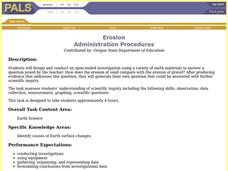Curated OER
Paleo-Dig
Students will comprehend the use of simple grids and the basic principles and skills used on a paleontological dig, such as the Illampi Mound Colony. They incorporate a systematic investigation. Students analyze a variety of different...
Texas State Energy Conservation Office
Investigation: Is Dilution the Solution?
Systematically diluting a full-strength sample of food coloring is meant to help earth scientists understand concentration in parts per million. While they will enjoy the lab exercise, it might be a challenge to help them relate it to...
Curated OER
Catapults
Students test catapults. In this physics lesson plan, student conduct scientific investigations that require them to test catapults. Students practice their problem solving skills as they employ the use of the scientific method.
Curated OER
What's Down There?
Investigate the coral reefs around Mokolai Island, Hawaii by researching and writing about improving the reef ecosystem. Learners map threats to the ecosystem and use the list of key words to assist in their descriptions
Serendip
Is Yeast Alive?
Through two investigations, life science learners determine whether or not yeast is alive. They perform tests for metabolism by providing sugar and observing if gas is produced as a byproduct. They incubate some of the sample for at...
Curated OER
The Rare Earth - How Rare Is Earth-Like Life?
Students systematically investigate the time frame for complex life to develop on Earth. They approximate how many other planets there may be harboring Earth-like complex life in our galaxy.
Curated OER
Assessing Risks for Inhalation and Ingestion of Pollutants
High schoolers use a hypothetical scenario to investigate inhalation of an airborne pollutant and ingestion of a waterborne pollutant. They work in pairs, investigating differences in overall exposure to contaminants by calculating...
Teach Engineering
Maximum Mentos Fountain
A messy fountain is potentially an energy experiment in disguise. Groups investigate the variables in creating a fountain from soda and Mentos. The last activity in a six-part series on energy has the class observe the fountain in terms...
Curated OER
Protective Services/ "Dump Busters"
Young scholars tell,write and show the importance of following correct procedures to promote safety of self, others, property, and shared resources. They
determine a crime suspect through systematic inquiry and objective information...
Curated OER
Erosion
Young scholars design and conduct an open-ended investigation using a variety of earth materials to answer a questions posed by the teacher: How does the erosion of sand compare with the erosion of gravel? After producing evidence that...
Curated OER
Scientific Investigation- Magnets
Students conduct a scientific investigation to determine if a magnet attracts paper clips through different materials. Students write out their procedures, collect data and present it in a table or chart, and analyze their results.
Curated OER
What's That?
Meant to be a simulation of a deep-sea exploration, this requires that another activity be completed first. In that activity, titled "Animals of the Lost City," marine biology buffs construct murals of benthic communities. In this...
Curated OER
Alcoholic Fermentation in Yeast
Biology learners investigate the effect of sucrose concentration on yeast alcoholic fermentation. During the lesson,they compare and contrast the processes of cellular respiration and alcoholic fermentation. They design an experiment to...
Curated OER
Classification: Dichotomous Key
Students investigate the classification process and nomenclatures used for classifying organisms. They study dichotomous keys to identify organisms with 90% accuracy. Students organize information regarding the relatedness of species.
Curated OER
Using Inspiration To Support Logical Reasoning
Students share descriptions of science experiments they have conducted. They create a thin film on the surface of water in order to float light objects and observe that a paper clip does, indeed, float on the surface of the water at...
Curated OER
Barometer Investigation
Students construct a barometer to use in an experiment that they design to measure the air pressure on a daily basis. These observations of air pressure allow students to determine how weather is affected when a storm is approaching and...
Curated OER
Determine the molarity of an unknown HCl solution
Students complete a lab to help develop a comprehension of stiochiometry. They review equation writing, equation balancing, and stiochiometry. Studnets are given the following information: Sloppy students from the previous class have...
Curated OER
Bowen's Reaction Serives: Magma Differentiation
High schoolers investigate the differentiation of magma to form different minerals present in a rock. By using the model proposed by Bowen, they determine the depth, temperature, and composition of magma. Students explain why some...
Curated OER
How the Environment Affects Our Health
Ninth graders explore how the environment affects health. In this infectious disease lesson, 9th graders investigate what environmental situations cause infections diseases. Students study the symptoms, treatments, prevention, and...
Curated OER
Magnetism
First graders investigate magnetism. In this magnetism lesson, 1st graders classify objects as being magnetic or nonmagnetic. Students receive a pile of objects to test. Students test the items and give a rationale of why they think the...
Nuffield Foundation
Measuring the Vitamin C Content of Foods and Fruit Juices
Are you getting enough vitamin C? Young scientists determine the amount of vitamin C in fruit juice samples. They accomplish this task by adding DCPIP solution to the samples until the blue color of the DCPIP persists. Once this happens,...
American Chemical Society
Neutralizing Acids and Bases
Now that your science class has experimented with pH indicator and identified acids and bases, they attempt to get the cabbage juice indicator back to its original color. This is done through neutralization of the acids and bases that...
Curated OER
Biomedical Engineering and Quality of Life Improvements
Students complete an observational or natural science experiment. They do systematic and experimental work using experiments that have been done by others. They research their hypothesis and gather information from several sources. They...
Curated OER
Are You One of Us?
Students investigate how scientists sort and classify organisms. In this sorting and classifying activity, students examine what systematics are as tools that scientists use. They examine images of invertebrates and sort them while...

























